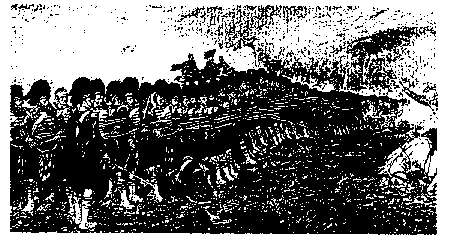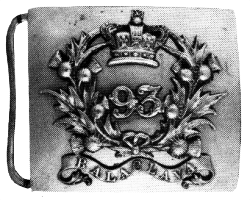



Recreated by Frontline Figures in 1996.
The Argyll and Sutherland Highlanders are perhaps one of the best known Highland regiments and the one with the most romantic associations. The regiments history dates back to 1794 but it assumed its present form in 1881 following the amalgamation of the 91st Argyllshire Highlanders and the 93rd Sutherland Highlanders. Better known in Scotland simply as the Argylls the regiment recruited in central Scotland (in the old counties of Stirlingshire and Clackmannanshire) and in the West of Scotland in Argyll.
The Sutherland Branch of the reqiment is particularly famed for its part in the Battle of Balaclava (1854) during the Crimean War.

The regimental badge is a circle inscribed Argyll and Sutherland surrounded by a wreath of thistles. In the centre the cypher of Princess Louise is reversed and interlaced with the princess's coronet mounted above The boar's head of the Duke of Argyll and the cat of the Duke of Sutherland lie within the circle.

The Argyll and Sutherland Highlanders have two mottos. The first is 'Ne Obliviscaris' (do not forget) the motto of the Duke of Argyll, and the second is 'Sans Peur' (Fearless) the motto of the Duke of Sutherland.
The association with Princess Louise, fourth daughter of Queen Victoria dates from 1870, when she became engaged to be married to the Marquis of Lorne, the eldest son of the Duke of Argyll, whose ancestor had raised the 91st Highlanders in 1794. In view of this, the 91st asked for and were granted the honour of forming the guard of honour on the day of the wedding in 1871.
After 1881, when the 91st and 93rd regiments became linked as the 1st and 2nd Battalion, The Argyll and Sutherland Highlanders, the association with Princess Louise's wedding was retained and woven into the badge of the new regiment, then known as Princess Louise's Sutherland and Argyll Highlanders.
The 93rd Sutherland Highlanders, raised in 1799 by Major General William Wemyss, a nephew of the Earl of Sutherland, was recruited under unusual circumstances for the period. General Wemyss had been particularly successful in recruiting two fencible regiments for home defence from Sutherland Estates and lands. The last of these regiments had just been disbanded when Wemyss set to work to raise the Sutherland Highlanders. Over 250 men joined from the fencibles, while the other 390 or so were raised by levey and ballots on the Sutherland Estates. In the years that followed the 91st Argyllshire Highlanders saw extensive service in the Cape of Good Hope and in the Peninsular Campaign, South Africa and the Zulu Wars (1879) The 93rd Sutherland Highlanders were present at the Cape of Good Hope, the Battle of New Orleans (1814) the Canadian Rebellion of 1838 and they played a distinguished part in both the Crimean War (1853-56) and the Indian Mutiny (1857-58).
Outstanding, unusual and unique are all words which can be applied to the many battle honours of this distinguished Regiment, one battle honour that stands distinctly apart, however, is that of 'Balaclava'.
The 93rd Sutherland Highlanders had fought with great courage at the Battle of Alma in September 1854, as part of Sir Colin Campbell's Highland Brigade. In October however, the 93rd were left behind in the port of Balaclava to unload stores, while the main army moved to Sebastopol to besiege the town.

Following several false alarms, and then with little warning, the Russians attacked and occupied forts and outposts protecting Balaclava. The 93rd were already under arms and in position and Sir Colin Campbell took his meagre force of cavalry, marines and Highlanders and immediately set up a defence. Remember there is no retreat, you must die where you stand he told them. As the Russian Cavalry advanced, the 93rd in line and only two deep, moved over the crest of a hill. For a long moment, all was eerily silent. The movement of the horses, the clinking of the sabres, the champing of bits could clearly be heard. No one spoke. The Russian Cavalry then charged head-long towards the slender British line, and side by side the 93rd stood firm and faced the approaching onslaught.
At 600 yards, they fired a volley into the enemy cavalry which had virtually no impact on its momentum. In the face of increasing volley fire and with the Highlanders line still unyielding, at 200 yards the leading cavalry finally began to break and wheeled to the left. The 93rd moved its defensive position in response and still stood its ground. The Russians, baulked by the 93rd's determination abandoned their attack, and withdrew. As they retreated across the plain pursued by artillery fire, the 93rd threw their bonnets in the air and cheered. "We expected to have to fight soldiers" one of the Russian Cavalrymen commented subsequently, - "not red devils".
Thus the action became the subject of the great Victorian painter, Robert Gibb, who painted the classic The Thin Red Line at Balaclava.
